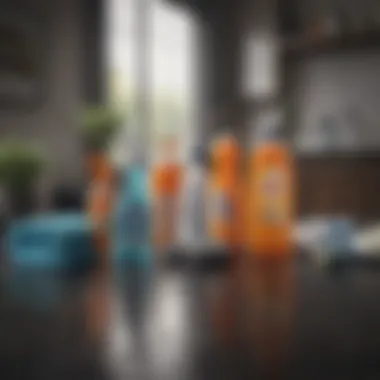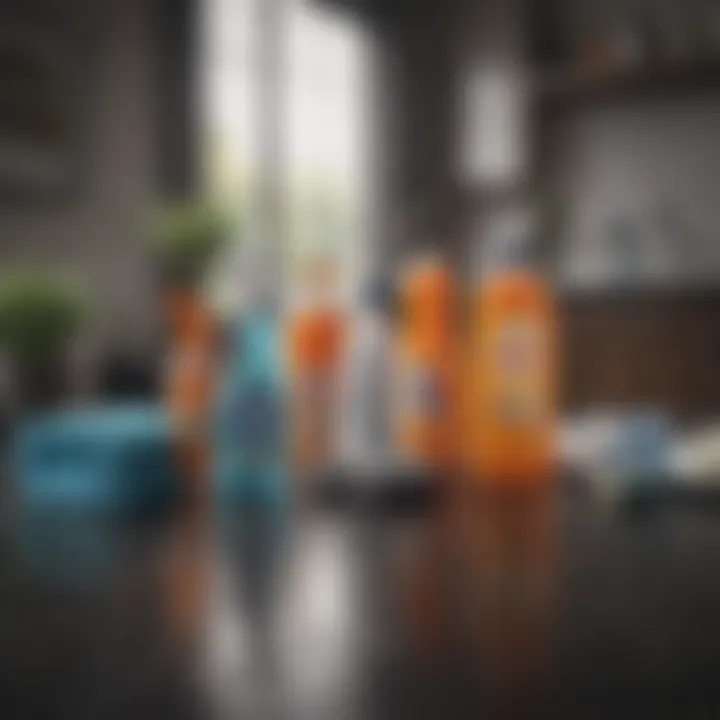Cleaning, Disinfecting, and Sanitizing Explained


Intro
Understanding the concepts of cleaning, disinfecting, and sanitizing is crucial for maintaining hygiene in our daily lives. These terms, while often used interchangeably, refer to distinct processes with different outcomes. This article aims to clarify these differences, elucidating the precise methodologies tied to each term and their implications.
In a world increasingly aware of public health issues, especially in light of recent global events, it is imperative to know which techniques to implement for varying situations. The ultimate objective is to empower readers to make educated choices about cleanliness in both residential and commercial settings.
By delving into the nuances of these methods, we will highlight how each contributes to reducing pathogens and achieving optimal hygienic standards. Successful hygiene maintenance blends these approaches, ensuring surface areas not only look clean but also remain safe.
Featured Homes
The interplay of cleaning, disinfecting, and sanitizing extends beyond just health. In maintaining beautiful homes, it also plays a significant role in preserving design elements.
Architectural Highlights
Architects and builders often focus on using materials that are both aesthetically pleasing and easy to maintain. For example, natural stone surfaces can present unique challenges; regular cleaning removes dirt, while disinfecting is essential to kill germs in kitchens and bathrooms. Understanding how to maintain these materials is vital for their longevity.
Interior Design Themes
Interior design trends often reflect an increasing emphasis on health and cleanliness. Minimalist designs, with fewer decorative objects, can ease the cleaning process. Lightweight and washable fabrics for upholstery also serve to enhance hygiene. Therefore, using cleaning techniques wisely can preserve and enhance the sophistication of any design theme.
Understanding the Terms
Cleaning
Cleaning simply involves removing dirt, debris, and impurities from surfaces. This process employs water, detergents, and mechanical methods, such as scrubbing or wiping. It may not eliminate all pathogens, but it sets the stage for further hygiene processes. Common cleaning practices can involve:
- Sweeping and vacuuming floors
- Wiping countertops with appropriate cleaners
- Washing fabrics such as curtains or upholstery
Disinfecting
Disinfecting goes beyond cleaning. It involves using chemical agents to kill germs, viruses, and bacteria on surfaces. This step is crucial, especially in public spaces or during a health crisis. Effective disinfectants must remain wet on the surface for a specified contact time to work effectively. Popular disinfecting agents include products containing bleach, hydrogen peroxide, or alcohol. Important steps in disinfecting include:
- First, clean the area to remove surface debris.
- Apply the disinfectant, ensuring the surface remains wet as per the product's instructions.
- Allow the disinfectant to air dry for effectiveness.
Sanitizing
Sanitizing serves a specific purpose, aimed at reducing the number of germs to a safe level. This can be particularly important in food preparation areas where maintaining hygiene is crucial but complete disinfection may not always be necessary. Sanitizers are used primarily in kitchens and bathrooms and can include products like hand sanitizers or specific food-safe sanitizers. The process generally involves:
- Cleaning surfaces first.
- Applying the sanitizer, following the instructions for proper dilution and contact time.
"Not all cleaning is equal. Knowing when to clean, disinfect, or sanitize can make a significant difference in maintaining a healthy environment."
Culmination
In a nutshell, cleaning, disinfecting, and sanitizing, while intertwined, represent distinct operations that serve different purposes. By understanding and utilizing these processes appropriately, individuals can ensure their surroundings are not only visually appealing but also hygienically safe. This knowledge contributes to informed decision-making, which is vital in today’s health-conscious world.
Intro
In today's world, maintaining cleanliness has become more crucial than ever. The aspects of cleaning, disinfecting, and sanitizing are often misunderstood, yet they play a vital role in safeguarding our health and well-being. This article seeks to clarify their distinctions and importance in various environments such as homes, businesses, and public spaces.
Understanding the differences between these processes is essential. Each method has unique purposes and applications, affecting the level of hygiene achieved in any given space.
Cleaning is the foundational step that removes dirt and grime. While it is primarily about visibility, it sets the stage for deeper sanitization processes.
Disinfecting goes further by targeting and neutralizing pathogens, which is particularly pivotal in environments where infections can spread easily.
Sanitizing is often confused with disinfecting but focuses instead on reducing the number of germs to a safer level. This differentiation is crucial in making informed decisions about hygiene practices.
By dissecting these terms, readers can appreciate their significance in creating safe and healthy spaces. With the rise of health concerns, especially during the recent global pandemic, understanding these methods can empower individuals and organizations to take effective actions.
Moreover, ensuring that hygiene is prioritized not only aids in preventing illness but also contributes to overall quality of life. Choosing the right method can influence health outcomes in both personal and communal settings.
This article aims to educate, providing insights into effective techniques and best practices for each aspect of cleaning, disinfecting, and sanitizing. Through detailed analysis, readers can gain the tools necessary for maintaining proper hygiene standards.
Defining Cleaning
Cleaning is a fundamental aspect of maintaining a healthy environment, both in homes and commercial spaces. It goes beyond mere aesthetics; it plays a vital role in safeguarding our health and well-being. In this section, we will delve into the importance of cleaning, exploring its purpose, common agents used, and how it applies to our daily lives.
Purpose and Process of Cleaning


The main goal of cleaning is to remove dirt, dust, contaminants, and impurities from surfaces and objects. This process is essential for not only creating a clean and visually appealing space but also for preventing the spread of germs and allergens.
When engaging in cleaning, one typically follows a systematic process. First, the area is assessed to determine the level of cleaning required. Then, tools and products are selected based on the surfaces and type of dirt. Finally, cleaning begins, usually starting from the top down to avoid redistributing dirt.
The process can range from simple tasks, like dusting and vacuuming, to more complex routines involving deep cleaning methods and specialized equipment. Each step is crucial and contributes to an overall healthier environment.
Common Cleaning Agents
Various cleaning agents are utilized during the cleaning process, each serving a specific purpose. Some of the most common cleaning agents include:
- All-purpose cleaners: These are versatile products suitable for various surfaces, offering convenience for everyday cleaning tasks.
- Disinfecting wipes: They provide an easy way to clean and disinfect surfaces quickly, ideal for high-touch areas.
- Glass cleaners: Specifically designed for windows, mirrors, and other glass surfaces, these formulas provide a streak-free shine.
- Specialty cleaners: These include products for specific materials, such as wood polish or carpet cleaner, ensuring each surface is treated with care.
It is important to understand the ingredients and safety precautions of each cleaning agent. Some may contain chemicals that require specific handling or personal protective equipment.
Applicability in Daily Life
Cleaning is not confined to professional settings; it permeates our daily lives. In a home, cleaning routines can vary based on personal habits and schedules. Regular cleaning of kitchens, bathrooms, and living areas is crucial in minimizing health risks.
In workplaces, cleaning often follows specific protocols to ensure health and safety standards are met. High-traffic areas may require more frequent cleaning to manage germs and maintain a hygienic environment.
Additionally, understanding the differences in cleaning processes can improve our effectiveness. For example, using the correct cleaning agents and techniques can enhance results and reduce effort. Overall, cleaning is an essential practice that impacts our health and quality of life.
Understanding Disinfecting
Understanding disinfecting is a crucial part of maintaining a sanitary environment, both at home and in professional settings. This section aims to clarify the concept of disinfecting, its benefits, and the considerations involved in its application. Disinfecting is not merely an option; it is essential for reducing the risk of infection, especially in spaces frequented by many individuals.
When we disinfect, we actively kill or inactivate harmful microorganisms. This process goes beyond simply cleaning a surface. It requires an understanding of the specific pathogens present and the effectiveness of various disinfecting agents against them. As society becomes increasingly aware of health risks, the importance of effective disinfection cannot be overstated.
Disinfecting Explained
Disinfecting refers to the process that eliminates or reduces pathogenic organisms on surfaces or objects. Unlike cleaning, which primarily achieves the removal of dirt and debris, disinfecting focuses on pathogens. This is often vital in places such as hospitals, kitchens, and bathrooms where the likelihood of pathogens is higher.
The process usually involves applying a disinfectant spray or wipe to a surface and allowing it to sit for a specified duration to effectively kill microorganisms. The time needed can vary depending on the disinfectant used and the type of pathogen targeted. The Environmental Protection Agency (EPA) provides a list of registered disinfectants, ensuring that users can select effective products for their specific needs.
Types of Disinfectants
Disinfectants come in many forms, each suited for various applications. Some common types include:
- Quaternary Ammonium Compounds (Quats): Effective against a range of bacteria and viruses, these are often found in household disinfectants.
- Bleach (Sodium Hypochlorite): A powerful disinfectant that can kill bacteria, viruses, and fungi when used correctly.
- Hydrogen Peroxide: This is a versatile disinfectant that breaks down into water and oxygen, making it less harmful to the environment.
- Alcohol Solutions: Typically containing 70% alcohol, these solutions are effective at inactivating many types of viruses.
Understanding these options allows users to select a disinfectant that aligns with their specific needs, ensuring effective pathogen reduction and maintenance of health standards.
Best Practices for Disinfecting
To ensure that disinfecting is both effective and safe, certain best practices should be followed:
- Read Labels: Always read the instructions on the disinfectant container. The manufacturer's guidelines include essential information about application, dwell time, and safety measures.
- Surface Preparation: Clean surfaces before disinfecting. Dirt can inhibit the effectiveness of disinfectants.
- Use Appropriate Amount: Apply enough disinfectant according to label directions. Under-application can lead to inadequate pathogen reduction.
- Ensure Proper Ventilation: Some disinfectants can produce harmful fumes. Adequate ventilation can minimize exposure to these compounds.
- Regular Frequency: Establish a routine disinfecting schedule, especially in high-touch areas, to maintain a consistently safe environment.
Best practices in disinfecting can significantly enhance public health and safety, especially in shared spaces.
By adhering to these principles, individuals and businesses can ensure that their disinfecting efforts are both efficient and effective.
Exploring Sanitizing
Sanitizing plays a crucial role in maintaining hygiene, especially in spaces that serve a large number of people. This section aims to uncover its significance, effective techniques, and how it differs from cleaning and disinfecting. Understanding sanitizing is essential for anyone concerned with creating safe environments, whether in a household or a commercial setting. It helps reduce the number of germs and bacteria, making spaces safer for frequent use.
What is Sanitizing?
Sanitizing refers to the process that reduces the number of microorganisms on equipment and surfaces to a safe level as deemed by public health standards. Unlike cleaning, which primarily removes dirt and debris, sanitizing specifically targets bacteria and viruses. It is particularly important in settings where people gather, such as restaurants, schools, and healthcare facilities. The methods used for sanitizing must be effective enough to lower microbial counts, thus preventing potential infections.
Sanitizing Techniques
Several techniques can be employed for effective sanitizing. These methods can vary based on the environment and the materials involved. Here are common sanitizing techniques:
- Heat Sanitizing: This method involves using high temperatures to kill germs. It is effective on surfaces that can withstand heat, such as kitchen equipment.
- Chemical Sanitizing: Chemical agents, including chlorine bleach, hydrogen peroxide, or quaternary ammonium compounds, can be used to sanitize surfaces. Each solution has its specific instructions regarding concentration and contact time for effectiveness, making it important to read labels carefully.
- Ultraviolet (UV) Sanitizing: Utilizing UV light can effectively reduce microbial presence without chemicals. This method is often used in water treatment and some surface sanitizing applications.
It is vital to follow the correct procedures associated with each technique to maximize effectiveness and safety.
Comparison with Cleaning and Disinfecting


In understanding sanitizing, it is essential to distinguish it from cleaning and disinfecting. While they may seem similar, they serve different purposes:
- Cleaning removes dirt and grease but does not necessarily kill germs. It is often the first step in maintaining hygiene but should not be viewed as a standalone method for health safety.
- Disinfecting goes a step further by killing a wider range of pathogens. It is more aggressive in terms of microbial removal compared to sanitizing. Disinfecting is typically used in situations where bacteria or viruses pose a higher risk.
- Sanitizing, however, aims to reduce pathogens to levels considered safe by public health standards, which can be sufficient in many situations.
Having a clear understanding of these processes allows individuals and organizations to make informed decisions on their hygiene practices. Depending on the context, one may prefer sanitizing over disinfecting or cleaning, according to the specific needs and potential health risks present.
Key Differences Between Cleaning, Disinfecting, and Sanitizing
Understanding the differences between cleaning, disinfecting, and sanitizing is crucial, especially in the modern context of health and safety. Each method plays a distinct role in maintaining hygiene, yet they often get confused or used interchangeably. Recognizing the unique purposes and processes behind each can lead to more effective strategies for pathogen control and overall cleanliness. This section aims to highlight these differences, evaluating their importance in daily life and various environments.
Mechanisms of Action
Cleaning, disinfecting, and sanitizing engage with surfaces and pathogens in different ways.
- Cleaning primarily involves the removal of dirt, food residue, and debris. It works mechanically to lift particles from surfaces. Common methods include scrubbing or wiping down surfaces with water and cleaning agents.
- Disinfecting actively destroys or inactivates bacteria and viruses on surfaces. It typically uses chemical agents, such as bleach or alcohol, that target and kill pathogens.
- Sanitizing reduces the number of microorganisms to a safe level, as judged by public health standards. This is often achieved using less potent chemicals than disinfectants.
Overall, understanding the mechanisms of action helps in determining the right method for the situation, ensuring that cleanliness and safety expectations are met.
Effectiveness Against Pathogens
Evaluating the effectiveness of each method against pathogens is essential for health safety.
- Cleaning is not sufficient for killing germs but is necessary for compliance with further hygiene steps. Removing physical contaminants lays the groundwork for subsequent actions.
- Disinfecting is the most potent of the three methods when it comes to pathogen control. Effective disinfectants can eliminate about 99.9% of germs on surfaces.
- Sanitizing falls between the other two. While it can lower the number of germs, it may not be effective against all pathogens, especially in high-risk environments.
The choice of method can significantly affect the health outcomes in various settings, impacting public and personal health.
Recommended Contexts for Use
Each method of cleaning, disinfecting, and sanitizing is suited to particular environments and situations.
- Cleaning is typically adequate for everyday tasks in homes or offices where the risk of infection is minimal. Regular cleaning helps maintain a pleasant and healthy space.
- Disinfecting is recommended in high-risk areas such as hospitals, kitchens, or bathrooms—places where pathogens are likely to thrive. This ensures a safer environment, especially during flu seasons or outbreaks.
- Sanitizing is suitable for food contact surfaces and child play areas, reducing the chance of illness while allowing some level of cleanliness without the harshness of disinfectants.
Understanding when to apply each technique is key to creating a personalized cleaning protocol. Utilization of the appropriate method correlates directly with health outcomes.
Using the right method for cleaning, disinfecting, and sanitizing is an important part of maintaining public health and personal safety.
Implications for Health and Safety
Understanding the implications for health and safety in the context of cleaning, disinfecting, and sanitizing is essential. These practices have profound effects on both individual and public health. When executed properly, they minimize the spread of pathogens and contribute to overall well-being in various environments.
Cleaning surfaces effectively removes dirt, debris, and some germs, establishing a fundamental layer of hygiene. While it does not eliminate all pathogens, it prepares the area for subsequent disinfecting or sanitizing processes. The consideration of these steps is crucial in maintaining environments free from harmful microorganisms.
Disinfecting takes this a step further. It significantly reduces or eliminates pathogens on surfaces, enhancing safety in homes, schools, offices, and healthcare settings. This process is especially relevant in contexts where the risk of infection or disease transmission is high. Understanding the role of disinfectants, including their specific application and effectiveness, becomes vital in safeguarding public health.
Sanitizing plays a complementary role by ensuring that surfaces meet a certain level of cleanliness deemed safe by public health standards. By clarifying these distinctions, individuals can make informed choices regarding which methods to implement based on their specific circumstances.
Overall, recognizing the implications of these practices extends beyond the individual level. The collective impact on community health cannot be overstated. Effective cleaning, disinfecting, and sanitizing practices reinforce the broader public health framework, supporting initiatives during health crises and beyond.
"Effective hygiene practices pave the way for healthier environments and reduce the risks of outbreaks."
Impact on Public Health
The relationship between cleaning practices and public health is significant. Proper hygiene not only protects individuals but also helps to prevent the spread of infections within communities. In light of recent health crises, such as the COVID-19 pandemic, the need for effective cleaning has gained priority.
When spaces, such as schools and communal areas, prioritize regular cleaning and disinfecting, they contribute to a healthier society as whole. Most common ailments find their way into public spaces. Some of these can be combated effectively through regular hygiene measures. Encouraging diligent cleaning protocols can drastically reduce infection rates, thereby promoting public health initiatives.
Considerations in High-Traffic Areas
High-traffic areas, like shopping malls, airports, and office buildings, pose unique challenges for maintaining hygiene. Because these environments experience considerable footfall, they require targeted cleaning strategies.
In these contexts, surface cleaning with appropriate agents becomes essential, followed by effective disinfecting routines. Consideration of touchpoints, such as door handles and light switches, is crucial. These surfaces warrant frequent cleaning as they harbor more pathogens due to constant human contact.
Organizations should consider implementing routine guidelines tailored to the specific needs of these spaces. Developing a cleaning protocol that addresses frequency and method helps maintain safety standards. Engaging staff training ensures that the team is knowledgeable in effective cleaning methods tailored for high-traffic areas.
Enhancing Personal Hygiene Practices
Personal hygiene becomes a vital complement to environmental cleaning and disinfecting efforts. Encouraging individuals to adopt proper hygiene practices helps limit pathogen transmission. Basic steps, including regular handwashing and the use of hand sanitizers, can significantly reduce the likelihood of illnesses.
In homes, maintaining personal hygiene is important, especially in the context of shared spaces. For families, reminders about washing hands after returning home or before meals can foster a culture of hygiene.


Promoting awareness about the importance of cleanliness contributes to overall health. Educational campaigns highlighting personal hygiene practices can elevate community standards, leading to a safer environment for everyone.
By integrating personal hygiene with cleaning protocols, a comprehensive approach to health and safety develops, ultimately enhancing community well-being.
Regulatory Standards and Guidelines
Understanding regulatory standards and guidelines is crucial when it comes to cleaning, disinfecting, and sanitizing practices. These guidelines are established to protect public health and ensure a consistent level of safety across various environments. They help inform users about which methods and substances are effective and safe for controlling pathogens.
Proper adherence to regulations can significantly reduce the risk of contamination in both homes and businesses. Moreover, they create a baseline for quality assurance. Compliance not only improves hygiene but also provides legal protection for businesses in case of health-related incidents.
Overview of Relevant Regulations
Regulations concerning cleaning and disinfecting can vary widely based on location and the type of environment. In the United States, the Environmental Protection Agency (EPA) plays a critical role. It evaluates and registers disinfectants, ensuring they meet specific efficacy requirements. Additionally, the Occupational Safety and Health Administration (OSHA) establishes standards for workplace safety that include guidelines for cleanliness and disinfectant use.
Most jurisdictions also have local health departments that dictate additional standards relevant to public health. For instance, restaurants and hospitals often face stricter regulations due to their higher exposure to pathogens. This regulatory landscape necessitates that businesses familiarize themselves with applicable laws.
Compliance with Best Practices
Compliance with established best practices is essential for effective cleaning and disinfecting. Best practices involve employing techniques proven to reduce pathogens to safe levels, thus protecting human health. This can include recommendations such as using the correct concentration of disinfectants, adequate contact time for products, and appropriate application methods.
Additionally, training staff on the latest protocols ensures that everyone understands their role in maintaining hygiene standards. Regular audits and assessments can also help identify areas requiring improvement, contributing to ongoing compliance with established guidelines. By adhering to these practices, organizations not only meet regulatory requirements but also enhance their credibility with customers and stakeholders alike.
The Role of Certifications
Certifications play a significant role in the cleaning and disinfecting industry. They signal compliance with rigorous quality and safety standards. Organizations such as the Institute of Inspection Cleaning and Restoration Certification (IICRC) and the American Society for Testing and Materials (ASTM) offer certifications that validate cleaning and disinfecting processes.
A certification can boost customer confidence. Consumers and businesses alike often prefer certified services, believing they adhere to higher standards. Moreover, certifications keep entities informed about the latest developments in cleaning technologies and practices. This knowledge is pivotal, considering the rapid evolution of cleaning agents and methods.
Choosing the Right Method for Your Needs
Choosing the right method for maintaining cleanliness in various environments is crucial for achieving the desired hygienic outcomes. Each method—cleaning, disinfecting, and sanitizing—serves specific purposes and offers distinct benefits. Understanding when and how to use each technique can lead to better health outcomes, especially in settings where sanitation is paramount.
Assessing the Environment
Before determining which cleaning method to employ, it is vital to assess the environment in which you are operating. The factors at play can significantly influence the efficacy of any cleaning procedure. For instance, high-traffic areas, such as hospitals or schools, require more rigorous disinfecting protocols due to a greater risk of pathogen transmission. Conversely, residential spaces might prioritize simple cleaning techniques to maintain general cleanliness without necessarily aiming for pathogen elimination.
Key elements to consider include:
- Foot Traffic: Areas with high foot traffic are more prone to accumulating dirt and germs.
- Surface Types: Different materials can react variably with cleaning agents. For example, porous surfaces may harbor bacteria more effectively than non-porous ones.
- Public Interaction: In spaces frequented by the public, extra care is necessary to mitigate health risks.
Factors Influencing Method Selection
The choice between cleaning, disinfecting, or sanitizing is influenced by several factors that should be evaluated thoroughly. Understanding your specific needs will guide the appropriate choice. Two primary factors are:
- Type of Contaminants: If the primary concern is visible dirt, then cleaning may be sufficient. If the risk involves harmful pathogens, disinfecting is necessary.
- Duration of Effectiveness: Disinfectants may require longer contact times to work effectively, while sanitizers often offer quicker action.
Moreover, regulatory recommendations may also guide the selection process, particularly in commercial settings to ensure compliance with health standards.
Cost Considerations
Cost is an important element when selecting the appropriate cleaning method. This can encompass various aspects:
- Initial Investment: Some methods may require initial investments like professional-grade equipment or specialized cleaning agents.
- Ongoing Expenses: Consumables such as disinfectants or sanitizers must be factored in for long-term maintenance strategies.
- Time Investment: While some methods, such as disinfecting, may require more time, the long-term health benefits can justify the added expense.
It is important to weigh these costs against the potential benefits to ensure that you make an informed choice. Investing in the right method can lead to healthier spaces, reducing costs associated with illness or long-term damage due to neglect.
In summary, understanding how to choose the right method for your needs requires careful consideration of the environment, specific factors affecting that environment, and the perceived costs involved. These considerations are integral to maintaining hygienic standards and protecting health.
Closure
The importance of the conclusion in this article cannot be overstated. It serves as a comprehensive summary of the key points discussed throughout the sections on cleaning, disinfecting, and sanitizing. By distilling complex information, the conclusion aims to reinforce the critical distinctions among these essential hygiene practices. Understanding these differences is vital for both personal and public health.
Final Thoughts on Cleaning, Disinfecting, and Sanitizing
In summarizing the insights presented in this article, it is clear that cleaning, disinfecting, and sanitizing are interrelated yet distinct processes. Cleaning removes debris and dirt, disinfecting reduces pathogens to safer levels, and sanitizing eliminates many germs but may not kill all. Each method has its own significance in promoting health.
Adopting a methodical approach towards cleanliness not only benefits residential and commercial settings but also contributes positively to community health. The choice of which method to use should be based on the specific circumstances and needs at the moment. For example, high-touch surfaces require frequent disinfection, while general household cleaning tasks might only necessitate a thorough cleaning approach.
Encouraging Responsible Practices
It is imperative to encourage responsible practices in our daily cleaning and disinfecting routines. This includes being informed about the products used and the effectiveness of each method employed. Individuals should select appropriate agents and techniques that are not only effective but also safe for the environment.
Consideration should be given to what products are used, especially in homes where children and pets are present. Users should always adhere to manufacturer instructions for best outcomes and to ensure safety. Additionally, it is essential to regularly update knowledge on the latest guidelines and recommendations from health authorities, particularly in light of changing public health landscapes.
"Informed choices lead to better health outcomes."
In summary, responsible hygiene practices significantly enhance our collective well-being. It calls for heightened awareness and commitment to understanding the nuances between cleaning, disinfecting, and sanitizing.







